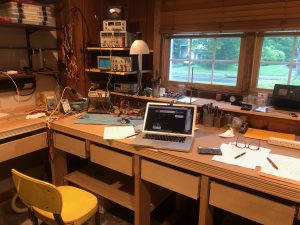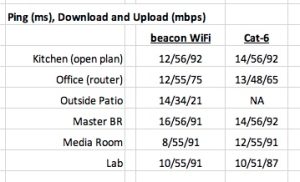The Nokia Beacon is a new entry into Mesh WiFi, but unlike others, Nokia targets service providers (SPs) as partners and channels with a variety of advanced, remote and cloud-based optimization and troubleshooting capabilities (such as things like TR-069). While this is an attractive thesis, it begs the questions: “is the Nokia Beacon system competitive?” and “Does it truly make a major improvement in home WiFi?”. We have now tested it and feel that it does. But rather than accept that “binary” answer, read on.
Is the Nokia Beacon competitive?
In an effort to answer those questions, Nokia send me a Beacon 3 set to evaluate in my home and home office/lab environment. It replaced my Verizon FiOS quantum router/AP— and my several attempts at WiFi range extenders — all abject failures not just in performance but in compatibility with advanced services. The kit includes 3 identical beacons, one of which takes the role of “base” (router) and the other two become satellites. Beacons communicate with each other constantly for back-haul, and also to optimize configurations and to manage automated hand-offs. You never change SSID or subnet and never need to make manual selections. It just happens (as with most mesh systems).
Configuration and options with telco-supplied broadband
Often consumers are faced with complications since CSP broadband is often tightly integrated with the home router/gateway and depends on its unique functionality — Verizon no exception. My fist pleasant surprise is that i could keep the Verizon router, intact, but with WiFi turned off. For FioS video customers this is important – if the router is not routing, STBs may not update properly. The Nokia Beacon supports this configuration, as well as a variety of configuration architectures, all available on Nokia’s website. Mine follows the diagram below. Logically it works as follows:
- Fiber to O/E in garage
- O/E to office (router, Beacon Base) via COAX
- FiOS router converts COAX to Ethernet. It is connected directly to the “base” Beacon. Continues to route.
(FiOS router has no other connections to the home LAN, but speaks to STBs over Coax) - (Cat-6) running from base router to the locations of the other two beacons so it has wired back-haul. Wireless back-haul is also supported.
Coverage
The three beacons do an excellent job of covering my very rambling house, which is 3000 sqft, spread over 5 “half” levels from basement to upper floor. Not only that, but the mesh provides good coverage outdoors in my garage, driveway, patio and back porch. 50 Mbps uploads from the back patio? Not too shabby. In fact, in my experience I now have strong coverage everywhere. Devices (phones, laptops, media servers, even test equipment) connect to the optimal beacon, automatically and transparently. Unlike extenders, multicast apps work seamlessly across the three nodes, and the system is smart enough to load balance if that is an issue.

![]()
testing in my semi-basement lab; beacon softly glowing in media room, between streaming bridge and TV
Performance (numbers!)
Even more impressive: Wifi and Ethernet speeds, where I had both available, were nearly identical.
So how good is the performance? Let’s begin with the fact that this is measured on FiOS 50/50 Mbps symmetrical. I measured performance using speediest.net at five locations, and I picked some of the most remote and difficult nooks and crannies. The table of results is below, but you can see that I typically got 50mbps downloads and 80 mbps uploads — and the biggest variance was time of day, suggesting that network congestion, not WiFi, was often the limiting factor. Even more impressive: Wifi and Ethernet speeds, where I had both available, were nearly identical. That never happens. Without back-to-back evaluations I cannot say whether the Nokia Beacon is superior to Google Mesh, Amplify and other acknowledged leaders. My only experience with those came before I re-arranged my house, and before COVID-19 changed traffic loads on networks. What I can say is that it performs admirably.

source: Appledore research; tests performed on MacBook Pro (2011) High Sierra, over FiOS 50/50 Service
Comparisons to the old system
- Overall speed tripled at least
- Dead spots were largely eliminated
- Outside became feasible
- Apps that rely on multicast suddenly worked more consistently
In fact, I didn’t even bother connecting my TV or High-Definition music bridge via ethernet. The difference in speed was that small
Any sufficiently advanced technology is indistinguishable from magic – Arthur C. Clarke
It is difficult to see or measure how well the remote management and optimization works. As Arthur C. Clarke quipped: “Any sufficiently advanced technology is indistinguishable from magic”. Like most automated systems, there is nothing to see — but magic apparently is happening in the background. I wish there was something I could monitor and report on, but no such data exists.
My experience with these three cylinders says that CSPs have a potential opportunity to bundle an excellent solution, eliminate a bottleneck to their primary service, a partner that wants them as a channel, and feature that depends on CSP operations and infrastructure.
We have already indicated that in our opinion CSPs need to get into this game, and that there is a natural market for them Now it appears that a viable product is on the market. Let’s see what happens.
Thank you to Nokia for the evaluation samples and for excellent support during the necessarily rapid turn up.
Grant Lenahan
Appledore Research
